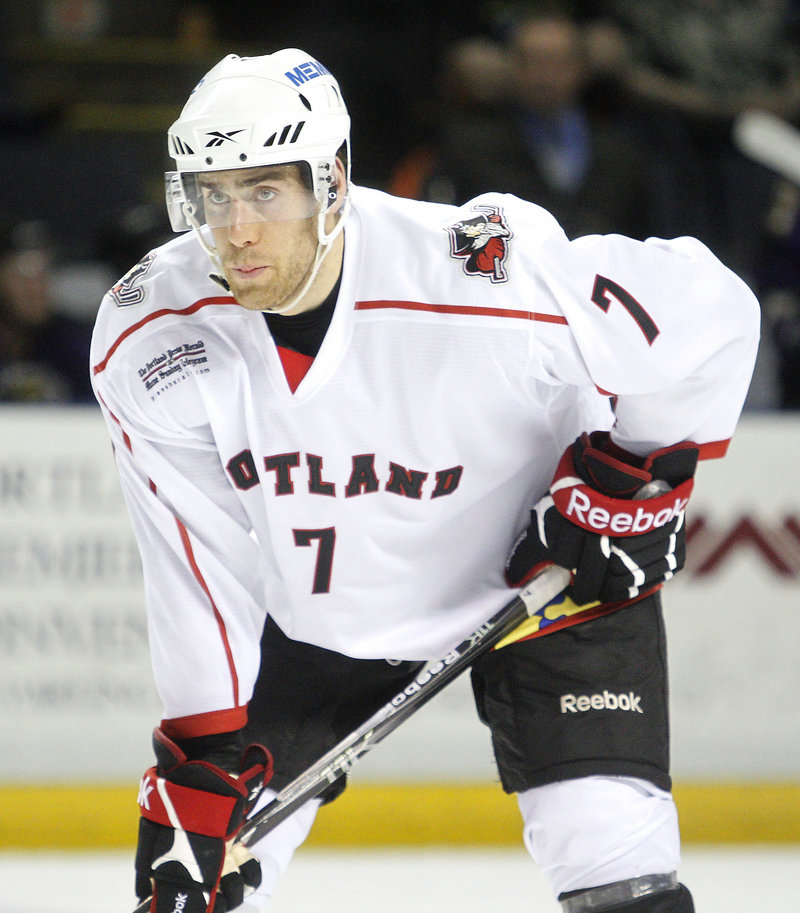PORTLAND – A rash of injuries and reassignments within the Buffalo Sabres’ organization prompted the need for immediate reinforcements in Portland, the organization’s American Hockey League affiliate. In the days after his team was eliminated from the NCAA hockey tournament, Kyle Ostrow got a phone call from his agent.
“You’re headed to Portland, Maine,” Ostrow’s agent said.
It was the end of a hectic process that came at the end of a hectic time for Ostrow, but it was the start of Ostrow’s professional hockey career after four years at the University of Denver. Yet while Ostrow joined the Portland Pirates on an amateur tryout agreement — an ATO in pro hockey vernacular — he isn’t drawing a paycheck. Instead, Ostrow is working at a chance to earn a full-time paycheck as a pro.
The 23-year-old forward is one of a group of former college hockey players who are advertising their wares in the AHL as players who are on amateur tryout agreements, and there are no guarantees of a contract. After a certain period — a player can remain on an ATO for up to 25 games — a team can choose to keep the player or release him. For professional clubs, ATOs are a low-risk, low-cost way to assess talent while figuring out if and how a player fits that team’s needs. For players, it’s an opportunity to prove themselves.
“It’s a challenge for those guys to get over the hump and say, ‘I’ll have a chance to go in, I’ll have a chance to show them what I can do … but I have a chance to get hurt,’ ” said Pirates Coach Kevin Dineen, who handles his team’s ATO signings. “It’s a big step for these kids, to make that leap and to play one level below the NHL.”
A player agrees to a tryout with an AHL team as a free agent with only a nominal per diem as compensation and hopes to catch the eye of an NHL organization. Including Ostrow, the Pirates have seven players in their lineup on ATOs: defenseman Jeff Dimmen (Maine), goalie John Muse (Boston College), defenseman Eric Baier (Providence), forward Joe Whitney (BC), forward Shawn Szydlowski (Erie Otters) and defenseman Corey Fienhage, who played two seasons at North Dakota but spent last year with Kamloops of the Western Hockey League. They could remain with the team on an ATO for the AHL playoffs, or they could be looking for new teams once Portland’s regular season ends today.
“The Pirates asked me if I wanted to come down and help fill in over a stretch of seven games in nine days,” said Dimmen, who is one of five players from this year’s team at Maine to turn pro on an ATO. “They needed some bodies and asked me if I wanted to come help out, and I jumped at the opportunity. Teams have been watching you at the college level and some teams may not know how you transition. So this is a way for you to showcase your abilities.”
Some, like Ostrow and Dimmen, jump into a team’s lineup right away. Others practice with teams and hope for playing time, in addition to hoping to make a strong impression, not just on the home team but on other teams who may be looking to plug holes within an organization.
“You don’t know how long you’re here for, just trying out with a team,” Ostrow said. “Hopefully it helps me out for next year, to find a team and to get some experience. It’s to see what kind of level of hockey this is, so I can see how hard I need to work this summer.”
But there’s a process to get to the point of being offered an ATO. When a player is winding up his college career, coaches, family advisers, and NHL and AHL representatives are in the background, searching for the right opportunity for players. Unless an NHL team holds a player’s rights or he is an undrafted, NHL-ready prospect that a team can afford to sign, signing an ATO with a farm team is the best way to gain exposure.
Scott Norton of Norton Sports Management, based in Newport Beach, Calif., represents and advises 40 NHL and college players, including many who have gone from college to pro hockey. He explained that the decision to turn pro with a specific organization depends not only on the player but also on the situation the player goes into.
“It’s a very hectic time,” Norton said. “You’re trying to do two things. You’re dealing with the client and his personality and with the teams. You’re going through a team’s depth chart, their minor league system, their draft picks, how they’ve done with college free agents or, in the case of (Miami of Ohio’s) Andy Miele, with smaller forwards. You’ve got to juggle a few balls to get to that point.”
The responsibilities of identifying and signing players to an ATO varies. In some NHL organizations, that responsibility is held by an assistant general manager or the general manager of a minor league team. When handling the Pirates’ ATOs, Dineen relies on his network of coaches and scouts to develop a better sense of each player, as an athlete and an individual.
When a rash of injuries, call-ups and transactions hit the Pirates last week, Dineen used that network — including Maine coaches Tim Whitehead and Bob Corkum — to rustle up potential players who might fill holes on his roster.
And, Whitehead notes, there are “a ton of variables” that go into a player’s decision whether to and where to turn pro. Conversely, signing an ATO may not be in a player’s best interest. The timing of an offer may not be right, or a situation may not be the right one for a player.
“It’s a lot like the recruiting process,” Whitehead said. “It’s mostly doing research. It’s asking, ‘Where’s the best opportunity?’ The money isn’t a big factor. In Tanner House’s case, he’s got two years with the Oilers organization and that gives him more time to prove his worth. And in each case, it’s the needs of the team. Portland lost defensemen and that tipped the scales for Jeff.”
Still, there’s no guarantee of a professional contract. But there’s the guarantee of more ice time to reach the next level.
“What better way to make a living than to play pro hockey, you know?” Dimmen said. “My goal was always to play college hockey and to score one goal there. After that, what’s the next step? I’d like to score a goal in professional hockey. I’ll go from here and, hopefully, make a living out of it and have some fun.”
Staff Writer Rachel Lenzi can be reached at 791-6415 or at:
rlenzi@mainetoday.com
Send questions/comments to the editors.




Comments are no longer available on this story